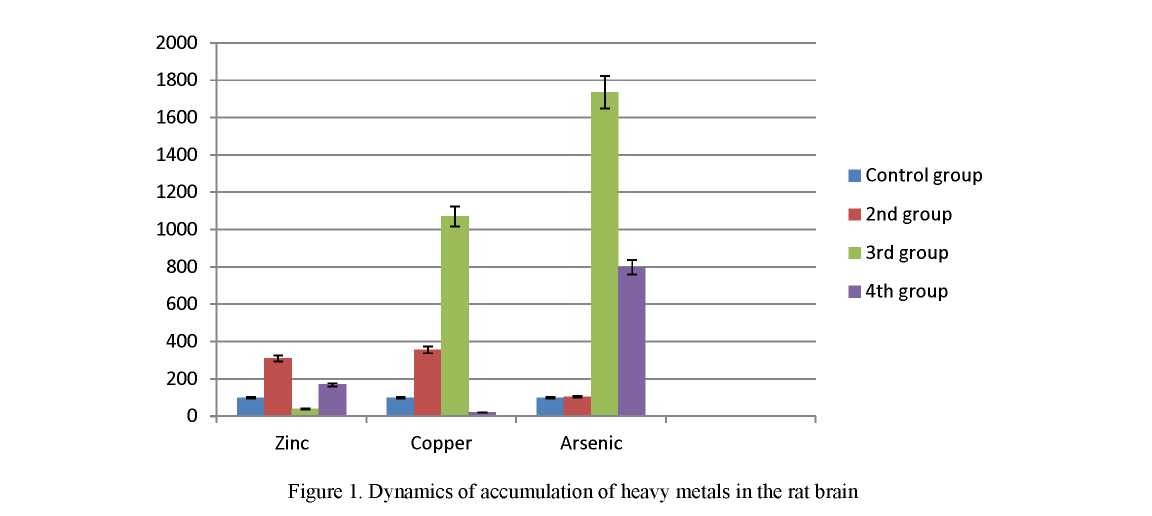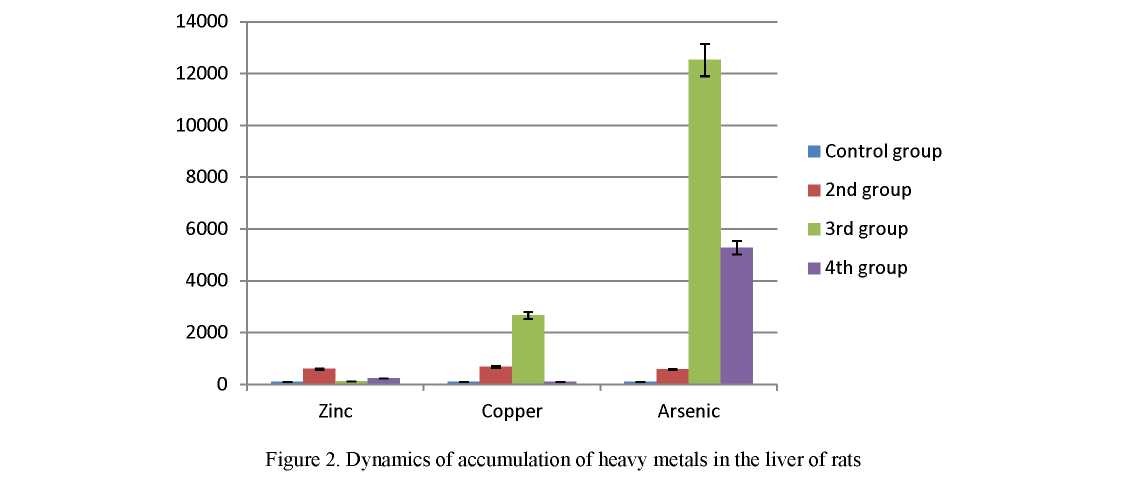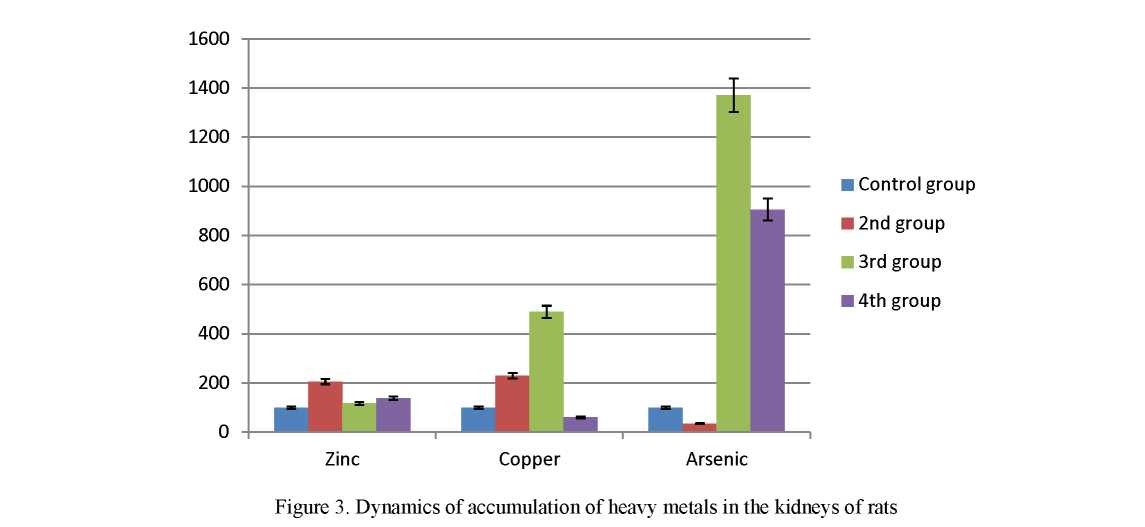The article indicates the results of a research made on the accumulation of heavy metals in some internal organs of rats under chronic combined poisoning with heavy metals salts (zinc, copper and arsenic). The experiments were carried out on 40 white outbred pubescent rats. They were divided into four groups. Heavy metals that can accumulate in the body of animals and humans, can lead to the internal organs dysfunction and organ systems disruption. Some heavy metals are able to selectively accumulate in a living organism. Therefore, the study was conducted of certain organs on the degree of accumulation of heavy metals. Salt solutions such as copper sulphate, zinc sulphate and sodium arsenite, which were injected intragastrically for three months on a daily basis, were used as toxicants. Sampling of organs was carried out after three months counting from the beginning of the experiment. The content of zinc, copper and arsenic was found in the brain, liver and kidney of a rat. The results of our studies showed that accumulation of heavy metals occurs to a greater extent in the liver of rats, and the group of copper and arsenic combined action showed the greatest toxicity in the degree of accumulation.
Introduction
Over the past decades, industrial production has increased, and the level of environmental pollution by various toxicants, including heavy metals, has increased as well [1]. Heavy metals are released into the environment as a result of the industrial and agricultural activities, vehicles and boilers. The main sources of heavy metals emissions are enterprises of nonferrous and ferrous metallurgy, mining complexes, and extraction of solid and liquid fuels [2]. Heavy metals make up a significant part of pollutant emissions, and their toxicity is a significant environmental problem [3]. Currently, the problem of pollution of the environment with heavy metals is relevant both worldwide and in Kazakhstan. In many regions of the country, the content of toxic substances in soils exceeds permissible levels, especially in the areas with developed mining and processing industries. For example, in Akmola region, there are mining deposits in which gold, uranium, titanium, iron, manganese, and molybdenum are mined. And the soils are contaminated with lead, copper, cadmium, zinc, arsenic, etc. [4].
It is known that metal elements whose density in comparison with water is higher are referred to heavy metals [5]. Many scientists attribute to heavy metals such elements whose atomic mass is above 50 atomic units, for example, V, Cr, Mn, Fe, Co, Ni, Cu, Zn, Mo, Cd, Sn, Hg, Pb, Bi, etc. [6]. Due to its high toxicity, arsenic is also classified as a heavy metal. It was reported that some metals, for example, cobalt, copper, chromium, zinc, copper, iron, magnesium, nickel and selenium are part of animal organisms and necessary for various biochemical and physiological functions. Lack of these elements can lead to various diseases development [7]. However, if ingested excessively, heavy metals can cause acute poisoning, as well as chronic use of toxic doses can cause chronic poisoning, and even death. Contacting the environment, heavy metals are able to accumulate in the soil, and then, along the food chain, reach plants and animals [8]. Accumulating in the soil, heavy metals can lead to deterioration in their quality, a decrease in the yield of crops cultivated on this soil, and a poor quality of agricultural products. This, in turn, creates a greater threat to human health, animals and the ecosystem as a whole [9].
Despite the biological role of heavy metals, they all have a toxic effect on living organisms, since they can interfere with metabolic processes, cause mutagenic processes, and also affect reproduction, which can lead to carcinoma and, ultimately, death. It has been reported that heavy metals usually exhibit chronic toxicity [10]. It is known that during intoxication various functional disorders arise, to which the immune system, the endocrine and central nervous systems react, and the metabolism is disturbed [11].
It was reported that with daily intake of zinc into rats' body, heavy metals are able to accumulate in it and cause morphofunctional changes in the animal organs with a chronic course. It was noted that the mucous membrane of the animals stomach treated with zinc oxide was altered by the type of catarrhal — hemorrhagic inflammation with micro ulcers. There is an increase of Peyer's glands in the small intestine; a large-drop fatty degeneration and granular fatty degeneration of hepatocytes in the liver; a circulatory disorder, granular dystrophy of the epithelium of convoluted tubules in the kidneys; catarrhal endometritis and endometrial epithelium hyperplasia in the uterus, proliferation of connective tissue in the ovaries; the processes of focal carination in the lungs [12].
Once in the body, heavy metals salts decompose into ions, resulting in the formation of insoluble hydroxides and phosphates, which are absorbed in the gastrointestinal tract. Free ions can quickly be removed from the blood and accumulate in the skeleton [13].
In animals, heavy metals and arsenic can be found in high concentrations and accumulate in the kidneys and liver. It is known that when entering the body, toxicants are able to change their shape and form poorly soluble compounds. Compounds of the same metal can exhibit different toxic effects [14].
There is the experimental and epidemiological evidence that the combined effect of heavy metals may differ significantly from the effects caused by the action of only a single metal. It is explained by the fact that when interacting with other toxic substances of the environment, the compounds which are formed cause higher toxicity [15-17].
It is known that heavy metals in tissues are usually deposited in the form of complex compounds with proteins and amino acids. However, their distribution in the internal organs is not the same. Sometimes it is selective. Summing up the facts mentioned above, it can be seen that it is necessary to study the accumulation of toxic metals in the body, the definition of a target organ. Therefore, the purpose of the study was to determine the concentration of heavy metals such as zinc, copper and arsenic in some internal organs of rats.
Materials and research methods
Experimental work was carried out on 40 white outbred pubescent rats. Laboratory rats were divided into four groups. The first group (n = 10) is a group of control animals. They were kept on a standard water and food ration. The second, third and fourth groups of animals were injected intragastrically for three months on a daily basis with solutions of heavy metal salts. The second group (n = 10) consisted of animals that were injected with a solution of zinc and copper salts, in doses of zinc sulfate of 17.5 mg/unit and copper sulphate II 13.0 mg/unit. The third group (n = 10) consisted of animals poisoned with salts of copper and arsenic, the dose of copper sulfate II was 13.0 mg/unit, sodium arsenite 1.0 mg/unit. A solution of zinc and arsenic salts was injected to the fourth group (n = 10) of the animals, a dose of zinc sulfate 17.5 mg/unit, sodium arsenite 1.0 mg/unit. During the experiment, animals were kept in conditions that meet the standards, according to the guidelines of The Guide for Care and Use of Laboratory Animals [18]. Feeding, care and removal of rats from the experiment were carried out in accordance with «STRK 1613-2006 Proper laboratory practice. The main provisions», as well as taking into account the Helsinki Declaration of the World Medical Association and the European Charter on the Humane Treatment of Laboratory Animals.
The arsenic content in samples of the liver, kidney, and rat brain was determined by electro-thermal atomization (ETA) on an MGA-915MD atomic absorption spectrophotometer. The content of zinc and copper was determined using the analytical STA voltamperometric complex.
Statistical processing of the data was performed on a personal computer, using the program Statistica 6, Excel. There were determined the arithmetic means (M), the standard error of the arithmetic mean (m). The assessment of the difference significance in arithmetic means was carried out using Student's criteria (t) and significance level (p). Differences were considered statistically significant at p < 0.05.
Results and discussion
In the course of the research, it was found that during chronic combined intoxication of rats with heavy metal salts, distribution and accumulation of heavy metals occurred in all the organs studied by us. However, the content of heavy metals in the organs of rats was not evenly distributed (see Table).
Table The content of heavy metals in the rats organs
|
Indicators |
1st group |
2nd group |
3rd group |
4th group |
|
|
Brain |
Zinc |
10 ± 0.18 |
31±0.61* |
4±0.24* |
17±0.53* |
|
Copper |
2.8±0.07 |
10±0.58* |
30±0.66* |
0.59±0.008* |
|
|
Arsenic |
0.08±0.002 |
0.085±0.002* |
1.39±0.006* |
0.64±0.006* |
|
|
Liver |
Zinc |
14±0.58 |
83±0.53* |
17±0.41* |
33±0.41* |
|
Copper |
2.06±0.01 |
14±0.65* |
55±0.75* |
2.1±0.06* |
|
|
Arsenic |
0.036±0.002 |
0.21±0.01* |
4.51±0.001* |
1.9±0.05* |
|
|
Kidney |
Zinc |
18±0.72 |
37±0.82* |
21±0.58* |
25±0.72* |
|
Copper |
10±0.37 |
23±0.72* |
49±1.52* |
6±0.38* |
|
|
Arsenic |
0.51±0.01 |
0.18±0.01* |
6.99±0.06* |
4.62±0.04* |
|
Note. * — the differences are significant compared to the control group, with p < 0.05.
In the studied samples, the zinc content was 3 times higher in the second group than the control group, and 2 times higher than in the fourth group. The third group showed significantly lower results than the control values. As it is shown in Figure 1, the copper content was 3 times higher in the second group and 10 times higher in the third group. In the fourth group, the amount did not exceed the control data.
Our results showed that the arsenic content was significantly higher than in the third and fourth groups, 16 times and 7 times higher respectively. In the second group, the zinc content was 1.4 times higher than in the fourth group, also in the second group the copper content was 5 times higher than the zinc content, 7 times higher in the third group. Probably, the accumulation of zinc was suppressed by the presence of copper. The arsenic content in the third group was also 9 times higher than in the fourth group. This is probably due to the fact that as a result of the combination of copper with arsenic, the accumulative effect is enhanced for both heavy metals. In the fourth group, the accumulative effect was manifested to a large extent for arsenic, in comparison with zinc.
Figure 2 indicates the results of the accumulation of zinc, copper and arsenic in the liver of rats, under combined chronic salts intoxication of the metals mentioned above. It can be seen from this figure that the zinc content was significantly higher than the control data, 5 times in the second group, slightly in the third group and 14 times in the fourth group compared to the data of the control group. The copper content increased in the second group by 6 times, in the third group by 26 times in comparison with the control group; in the fourth group it did not exceed the indicators of the control data. The arsenic content increased 5 times in the second group, 124 times in the third group, and 52 times in the fourth group. The data obtained show that the highest zinc content was observed in the second group, copper in the third group, arsenic — also in

the third group. This is likely to indicate a high toxicity of metals of the third group, namely combinations of copper and arsenic.
Figure 3 shows the results of the accumulation of zinc, copper and arsenic in the kidneys of experimental rats. As can be seen from the figure, the zinc content increased 2 times in the second group, slightly in the fourth and third groups. The copper content was 2.3 times higher in the second group, 4 times in the third group and decreased in the fourth group, in comparison with the control group. The arsenic content was significantly increased 13 times in the third group, 8 times in the fourth group compared with the control data, was lower than the control group in 2 times in the second group. The results show that the third group showed the greatest accumulation in the kidneys.
Conclusion
Under chronic combined poisoning, the group of the combined action of copper and arsenic showed the greatest toxicity according to the accumulation degree. In chronic combined intoxication with copper salts of arsenic, accumulation in decreasing order was observed in the following sequence: liver, brain, kidneys. In chronic combined poisoning with zinc and copper salts, accumulation in decreasing order was observed in


the sequence: liver, brain, kidneys. In chronic combined intoxication with zinc and arsenic salts, accumulation in decreasing order was observed in the sequence: liver, kidney, brain. The accumulation of heavy metals was observed to a greater extent in the liver of rats. Since the accumulation of heavy metals was mostly observed in the liver, this is probably due to the high sensitivity of the liver to the effects of toxicants. When heavy metals enter the body through the gastrointestinal tract, they enter the liver through the portal vein, so the liver is the first barrier to toxicants. Also, heavy metals are metabolized in the liver, during which the organ itself is damaged. Heavy metal ions from the blood penetrate into hepatocytes, while some are captured by liver macrophages, the rest is excreted into the intestine, where they are reabsorbed and during the hepatic recirculation, and re-entry into the liver. Since the kidneys were damaged by heavy metals during intoxication, and this could lead to the accumulation of urea and ammonia in the blood, it is likely that these substances acting on the liver cause damage to the liver. Based on the foregoing, heavy metals can accumulate in parenchymal organs, in the liver and kidneys according to our study.
References
- Bradl, H. (2005). Heavy Metals in the Environment: Origin, Interaction and Remediation. London: Academic Press.
- Revich, B.A. (2007). Problemy prohnozirovaniia, «horiachie tochki» khimicheskoho zahriazneniia okruzhaiushchei sredy i zdorove naseleniia Rossii [Forecasting problems «hot points» of chemical pollution of the environment and health of the population of Russia]. V.M. Zakharov (Ed.). Moscow: Akropol [in Russian].
- Jaishankar, M., Mathew, B.B., Shah, M.S., Krishnamurthy, T.P., & Gowda S.K.R. (2014). Biosorption of few heavy metal ions using agricultural wastes. Journal of Environment Pollution and Human Health, 2, 1, 1–6.
- Kurmanbaeva, A.S. (2011). Myshiak i rasteniia [Arsenic and plants]. Kokshetau [in Russian].
- Fergusson, J.E. (1990). The Heavy Elements: Chemistry, Environmental Impact and Health Effects. Oxford: Pergamon Press.
- Zaitseva, O.E. (2006). Osobennosti nakopleniia mikroelementov v platsente i pupovine pri normalnoi i oslozhnennoi hestozom beremennosti [Peculiarities accumulation of trace elements in the placenta and umbilical cord during normal and gestosis- complicated pregnancy]. Extended abstract of candidate's thesis. Moscow [in Russian].
- World Health Organization. Trace Elements in Human Nutrition and Health. (1996). Switzerland: Geneva.
- Long, X.X., Yang, W.Z. & Ni, W.Z. (2002). Current status and prospective on phytoremediation of heavy metal polluted soils. Journal Appl. Ecol., 13, 757–762.
- Gupta, V. (2013). Mammalian Feces as Bio-Indicator of Heavy Metal Contamination in Bikaner Zoological Garden. Research Journal of Animal, Veterinary and Fishery Sciences, 1, 5, 10-15.
- Skalnyi, A.V. (1990). Issledovanie vliianiia hronicheskoi alkoholnoi intoksikatsii na obmen tsinka, medi i litiia v orhanizme [The study of the influence of chronic alcohol intoxication on the metabolism of zinc, copper and lithium in the organism]. Extended abstract of candidate's thesis. Moscow [in Russian].
- Ermoshkaeva, E.P. (2004). Morfolohicheskie izmeneniia v orhanizme laboratornykh krys i ikh potomstva pri otravlenii uksusnokιslym svintsom i oksidom tsinka [Morphological changes in the body of laboratory rats and their offspring when poisoning with lead acetate and zinc oxide]. Extended abstract of candidate's thesis. Ekaterinburg [in Russian].
- Kolesnikov, V.A. (2009). Vozdeistvie tiazhelykh metallov na biohimicheskie reaktsii [Impact of heavy metals on biochemical reactions]. Vestnik Krasnoiarskoho hosudarstvennoho ahrarnoho universiteta — Bulletin of the Krasnoyarsk State Agrarian University, 106-109 [in Russian].
- Tarasov, A.V. (2006). Osnovy toksikolohii [Fundamentals of Toxicology]. Moscow: Marshrut [in Russian].
- Norwood, W., Borgmann, P.U., Dixon, D.G., & Wallace, A. (2003). Effects of metal mixtures on aquatic biota: A review of observations and methods. Hum. Ecol. Risk Assess. Int. J, 9, 795-811. Retrieved from http://sci-hub.tw/10.1080/713610010. pdf.
- Kortenkamp, A. (2007). Ten years of mixing cocktails: A review of combination effects of endocrine-disrupting chemicals. Environ. Health Perspect, 115, 98-105. Retrieved from http://sci-hub.tw/10.1289/ehp.9357.pdf.
- Mauderly, J.L., Samet, J.M. (2009). Is there evidence for synergy among air pollutants in causing health effects. Environ. Health Perspect, 117, 1-6. Retrieved from http://sci-hub.tw/10.1289/ehp.11654.pdf.
- Guide for Care and Use of Laboratory Animals. (1996). LAR publication: National Academy Press.
- Nadlezhashchaia laboratornaia praktika. Osnovnye polozheniia [Good laboratory practice. Main provisions]. (2008). ST RK 1613-2006 from 29th December 2006. Astana: Komitet po tekhnicheskomu rehulirovaniiu i metrolohii [in Russian].